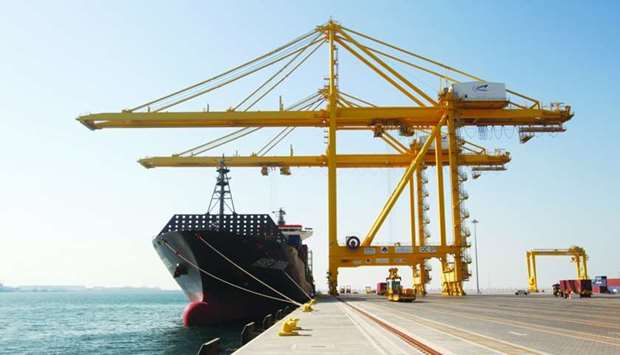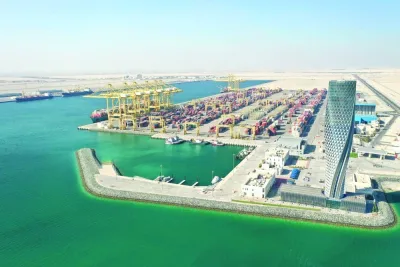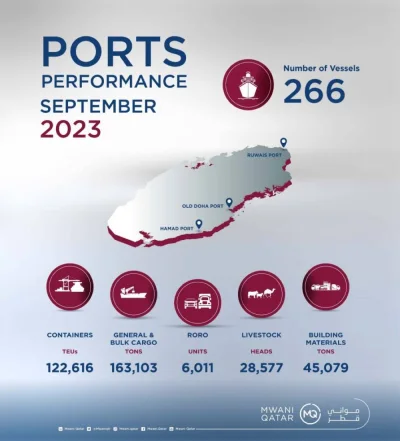The general cargo handling through Qatar's three ports – Hamad, Doha and Al Ruwais – more than tripled year-on-year in April 2020 amid challenges owing to Covid-19 that has already destabilised global maritime industry.
The general cargo handling registered a 236.33% year-on-year surge to 135,893 freight tonnes in April 2020. It was up 3.36% month-on-month, according to statistics released by Mwani Qatar.
Mwani Qatar is responsible for managing the nation’s seaports and shipping terminals, but the integrated port and logistics services provider is also playing a more pivotal role. It is responsible for Hamad Port and Al Ruwais Port which are commercial ports, as well as the development of Doha Port into a cruise port.
The general cargo movement has consistently increased from 57,016 tonnes in January, 85,916 tonnes in February and 131,472 tonnes in March, to a cumulative level of 410,297 freight tonnes in the first four months of this year.
The container handling through the three ports stood at 109,407 TEUs (twenty-foot equivalent units), which, however, fell 8.26% and 2.95% year-on-year and month-on-month respectively in April 2020.
The container movement had a chequered path in the four months and it cumulatively reported 445,335 TEUs during January-April this year.
The ports handled a total of 4,685 vehicles (RORO), which witnessed 22.99% and 23.05% decline on yearly and monthly basis respectively in the review period. In the first four months of this year, the cumulative figure stood at 25,161 units.
The three ports had handled 25,000 livestock in April this year, which fell 77.32% and 58.05% on yearly and monthly basis respectively. The livestock handled through the ports stood at 243,829 heads in the four-month ended April 30, 2020.
During the period in review, the number of ships calling on these ports stood at 127, which fell 54.64% and 43.56% year-on-year and month-on-month respectively. As many as 928 ships had called on three ports during January – April this year compared to 1,238 the year-ago period.
Hamad Port’s strategic geographical location offers opportunities to create cargo movement towards the upper Gulf, supporting countries such as Kuwait and Iraq, and south towards Oman, QTerminals chief executive Neville Bissett had earlier said.
Besides the usual handling of general cargoes, the Al Ruwais port is now handling the increased demand of foodstuff and other commodities. It provides a ready solution by acting as gateway for fresh commodities from neighbouring countries.
About 80% of world goods trade by volume is carried by sea and China is home to seven of the world’s ten busiest container ports, according to the United Nations Conference on Trade and Development.
Mwani Qatar is responsible for managing the nation’s seaports and shipping terminals, but the integrated port and logistics services provider is also playing a more pivotal role. It is responsible for Hamad Port and Al Ruwais Port which are commercial ports, as well as the development of Doha Port into a cruise port.
The general cargo movement has consistently increased from 57,016 tonnes in January, 85,916 tonnes in February and 131,472 tonnes in March, to a cumulative level of 410,297 freight tonnes in the first four months of this year.
The container handling through the three ports stood at 109,407 TEUs (twenty-foot equivalent units), which, however, fell 8.26% and 2.95% year-on-year and month-on-month respectively in April 2020.
The container movement had a chequered path in the four months and it cumulatively reported 445,335 TEUs during January-April this year.
The ports handled a total of 4,685 vehicles (RORO), which witnessed 22.99% and 23.05% decline on yearly and monthly basis respectively in the review period. In the first four months of this year, the cumulative figure stood at 25,161 units.
The three ports had handled 25,000 livestock in April this year, which fell 77.32% and 58.05% on yearly and monthly basis respectively. The livestock handled through the ports stood at 243,829 heads in the four-month ended April 30, 2020.
During the period in review, the number of ships calling on these ports stood at 127, which fell 54.64% and 43.56% year-on-year and month-on-month respectively. As many as 928 ships had called on three ports during January – April this year compared to 1,238 the year-ago period.
Hamad Port’s strategic geographical location offers opportunities to create cargo movement towards the upper Gulf, supporting countries such as Kuwait and Iraq, and south towards Oman, QTerminals chief executive Neville Bissett had earlier said.
Besides the usual handling of general cargoes, the Al Ruwais port is now handling the increased demand of foodstuff and other commodities. It provides a ready solution by acting as gateway for fresh commodities from neighbouring countries.
About 80% of world goods trade by volume is carried by sea and China is home to seven of the world’s ten busiest container ports, according to the United Nations Conference on Trade and Development.




